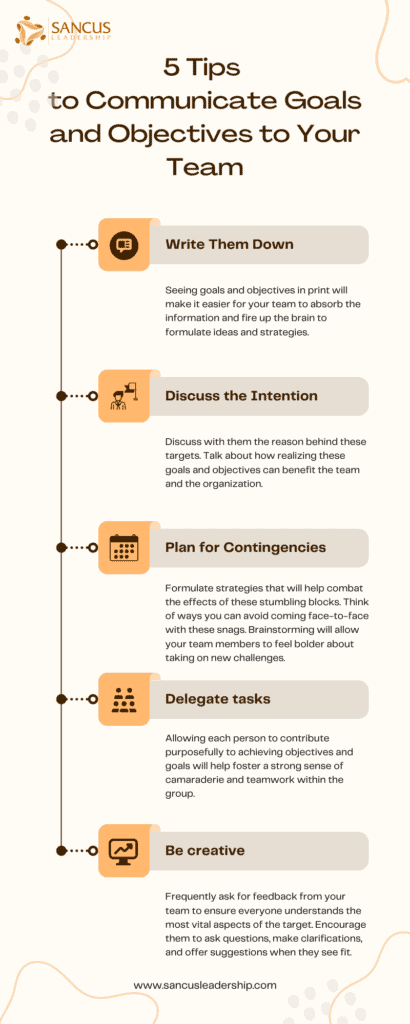In my twelve years of leadership positions, I have seen one thing that impacts performance almost as much as trust, the ability to motivate a team. But if you want to improve your “motivational skills,” you are approaching it wrong. Motivation is the result, not the means. Great leaders know that engagement and excitement come from a shared view of the future, a future worth pursuing. Our job as leaders is to make this future tangible and understandable!
Setting goals and objectives is one of the secrets of team motivation. It allows your team members to realize the significance of their roles in the grand scheme of things. Goals and objectives must be specific, clear, and challenging to motivate the team to push forward.
This article will discuss how setting goals, and objectives can motivate your team and impact their performance and growth. We will also discuss some of the most common mistakes and misconceptions most leaders have about setting targets, and then I will provide tips on how these can be avoided and how to cascade targets to your team effectively.
How Will Setting Objectives Motivate My Team?

Setting objectives will motivate my team by allowing them to see their unique and indispensable roles in the bigger picture. They’ll be eager to do their share when they realize their value. Ensure your objectives are precise so your team knows exactly what needs to be done and how to get there.
Goals are the results your team or organization wants to achieve within a given period. It represents the big picture with which everyone in the team must align.
On the other hand, objectives are specific tasks that will help achieve the goals. They are short-term agendas, bringing the team closer to the set goals.
Objectives are most effective when they are specific, clear, and challenging. These will keep your team members engaged and motivated to deliver high-performance levels consistently.
Be concise in setting and delegating objectives to minimize confusion and misunderstanding within your team. Set the bar high so members feel inspired to push themselves beyond their limits.
How Clear Goals and Objectives Helps a Team

Aside from boosting motivation, many benefits are linked to setting sound objectives for your team. Here are some of them:
Better Team Performance
It is worth noticing that you need goals and objectives to succeed! How can you complete the race if you still need a finish line?
It is worth noticing that you need goals and objectives to succeed! How can you complete the race if you still need a finish line?
And if you still need to complete something, how can you expect anyone to feel motivated? These are the underlying questions of team motivation.
Productivity significantly improves when team members can see the finish line. This motivates them to complete their tasks and accomplish objectives. This results in higher performance for the team.
Furthermore, the more objectives your people can realize, the more they will be inspired to push beyond their limits and believe in the team.
Boosted Engagement
Establishing shared goals and objectives will help make members feel a deeper sense of connection to the team and the organization. When they see how they all fit into the bigger picture, they will realize the need to share more of their time and skills.
It is vital to stay connected with everyone on the team to monitor each other’s progress and see how these developments affect your own.
Improved engagement will also afford your team members a sense of leadership and independence. Their motivation to succeed will encourage them to initiate efforts to ensure everyone stays on track.
Self-Development
Reveling in the sense of fulfillment that accompanies attaining objectives is incredible. Most people will view this as a motivation to strive harder, as they’ll see a lot of relevance and meaning in their work. They will then take new objectives and goals as opportunities to improve themselves.
You have probably noticed the same in your hobbies; the ones that you try out and initially succeed in doing are the ones that are the most fun and that you continue practicing.
Intrinsically motivated individuals will spend time developing their talents and skills. They will invest more effort in enhancing their competencies and feel more accountable for their work, inspiring them to learn and improve their skillset constantly.
| How Clear Goals and Objectives Helps a Team | Description |
| Better Team Performance | Productivity significantly improves when team members can see the finish line. This motivates them to complete their tasks and accomplish objectives. This results in higher performance for the team. |
| Boosted Engagement | Establishing shared goals and objectives helps team members feel a deeper sense of connection to the team and organization. |
| Self-Development | Accomplishing objectives leads to a sense of fulfillment and motivation to improve skills |
Here’s a video of a TED Talk done by John Doerr talking about the importance of having a goal-setting system like “Objectives and Key Results,” or OKRs.
4 Most Common Misconceptions on Goal and Objective Setting

Business planning involves deciding where to take your business and setting a clear course to get to where you want it to be. You must develop well-defined goals, specific and challenging objectives, and smart strategies to move in the right direction.
Effectively leading and managing a team calls for you to be level-headed, realistic, and risk-taking, especially when deciding how to steer your team according to the organization’s direction. However, it can sometimes be easy to fall prey to all the excitement, especially if you’re eager to complete things as efficiently as possible.
Effectively leading and managing a team calls for you to be level-headed, realistic, and risk-taking.
Here are some common misconceptions and mistakes leaders make when setting goals and objectives for the team:
1. Setting the Bar Too High
Goals and objectives must be attainable. Setting the bar too high may make your team members feel defeated and frustrated, especially when they realize they are gradually drifting away from attaining their objectives, no matter how hard they strive to move forward. It may affect their self-esteem and confidence.
But be aware that you don’t aim too low since this has the same effect of demotivating your people.
2. Setting Too Many Goals and Objectives
You may have lofty plans for the business and be fully aware that attaining goals and objectives is the key to success. However, remember that it isn’t reasonable to entrust all these to your team members. It would be best if you learned to prioritize to lead and manage your team forward efficiently.
Rank goals and objectives according to urgency and importance. Consider the time frame you’ll be working with and prioritize only those at the top of your list. This way, your team members will feel safe, and they’ll be able to focus on what truly matters.
Attaining goals and objectives entails support from various tools and resources. Influential leaders provide their teams with the means necessary for their success. Typically, sufficient time and a reasonable budget are what can equip your team to get to the finish line.
Ample Time
A reasonable and realistic timeline is necessary for your team members to execute their strategies and plans. These should also align with the organization’s long-term plans and the industry’s projections. Giving your team members more time to achieve their targets may encourage them while allocating too much time might make them feel demotivated.
Giving your team members more time to achieve their targets may encourage them while allocating too much time might make them feel demotivated.
Consider breaking down particularly challenging goals into smaller tasks. This tactic will allow your team members to accomplish smaller daily tasks rather than working on significant endeavors simultaneously. This may help prevent burnout and feelings of dissatisfaction. Small wins may also motivate your team members to keep pushing onward to their goals.
I often use the theory of gamification to drive engagement and employee satisfaction on my team.
Adequate Budget
Leading and managing your team means you’re the ship’s captain, and your team members are your sailors in ensuring the organization gets to its destination. As the leader, you must equip your team members with adequate financial resources to get the job done efficiently.
Plan and map out possible routes toward achieving goals and objectives. Be reasonable and practical in budget allocation, but ensure that your team members will never feel any lack of support from their leaders. A team that feels they’re assisted and championed will always be motivated to give it their best shot.
A team that feels they’re assisted and championed will always be motivated to give it their best shot.
An effective approach that I often use is to let the people closest to the problem spend the resources in the way that they believe will solve the issue the quickest. Just ensure that you are aiming to solve the same problem!
4. Not Allotting Time for Updates
The dream is to have a five-minute PowerPoint on the first of January where you present the goals and objectives of the year, return on the last of December, give every a high five for accomplishing all the goals, and then set new ones. But this is different from how life and business work.
It’s not enough to sit down with your team and strategize on how best to attain your goals and objectives, given the resources available. As a leader, you must also set aside time to regularly check in with your team members to monitor their progress. Regular updates will let you check how far you’ve gone as a team.
Periodic feedback sessions provide great opportunities to assure team members that they’re on the right track. These will also allow you and the rest of the team to harmonize so that the team functions as a solid, unified entity.
| Misconception | Description | Solution |
| Setting the Bar Too High | Setting goals and objectives that are unattainable | Set goals that are challenging but attainable |
| Setting Too Many Goals and Objectives | Assigning too many goals and objectives to team members | Prioritize goals based on urgency and importance |
| Unavailability of Support | Not providing necessary resources and tools for achieving goals | Provide team members with sufficient time and budget |
| Not Allotting Time for Updates | Neglecting to regularly check in with team members | Schedule periodic feedback sessions to monitor progress and provide opportunities for team harmonization |
Tips for Setting Objectives

Leading and managing a team requires you to be adept at handling the reins, as the bulk of the responsibility for achieving goals rests on your shoulders. You must motivate your team to give 100% of their effort. Setting ambiguous objectives can cause uncertainty and misconceptions among team members.
Here are some essential qualities that sound objectives must have:
- Precision: Let your team members know exactly what needs to be done. Be straightforward in sharing details and information that will help make objectives easier to grasp.
- Clarity: Set a clear timeline for each objective. Answer any questions from team members to ensure that they all fully understand what needs to be done and when it needs to be accomplished.
- Relevance: All team objectives must be aligned with the organization’s goals. If objectives make sense, your team members will be motivated to take part in bringing them to fruition.
- Challenging: Objectives must have a degree of difficulty so your team members will be motivated to push. Driven individuals will undoubtedly love the challenge.
- Realistic: Objectives must be challenging yet attainable. It would be almost pointless to set objectives beyond the reach of your team members since these might only serve to make them feel incompetent. On the other hand, setting the bar too low may make them feel demotivated.
| Element | Description |
| Precision | Communicate objectives clearly and explicitly to your team members. Share information that helps them understand what needs to be done. |
| Clarity | Set specific and clear deadlines for each objective. Encourage your team members to ask questions to ensure they fully understand what needs to be done and when. |
| Relevance | Ensure that each objective is aligned with the organization’s overall goals. When objectives make sense, team members will be more motivated to achieve them. |
| Challenging | Set objectives that are challenging enough to motivate team members to work hard and push themselves to achieve them. |
| Realistic | Set objectives that are attainable yet challenging. Objectives that are too easy may demotivate team members, while objectives that are too difficult may make them feel incompetent. |
How to Communicate Goals and Objectives to Your Team

Goals and objectives are what keep a business moving forward. As an effective leader, you must communicate these to your team in ways that will motivate them and inspire them to take action. Constructively presenting the goals and objectives will be crucial.
Here are some tips on how you can effectively communicate goals and objectives to your team members:
Write Them Down
There is something about visual representations that make it easier to process information. Instead of simply stating goals and objectives to your team members, write them down. Seeing goals and objectives in print will make it easier for your team to absorb the information and fire up the brain to formulate ideas and strategies.
Seeing goals and objectives in print will make it easier for your team to absorb the information and fire up the brain to formulate ideas and strategies.
Discuss the Intention
Goals and objectives will only carry a little weight and meaning if your team members are kept in the dark about their purpose.
Discuss with them the reasons behind these targets. Talk about how realizing these goals and objectives can benefit the team and the organization. Being clear about the intentions will help motivate your team members to engage and participate in their achievement.
Plan for Contingencies
Brainstorm with your team the obstacles that may stand in your way. These will significantly affect how quickly you’ll achieve goals and objectives, so it’s wise to consider ways to overcome them early on.
Formulate strategies that will help combat the effects of these stumbling blocks. Think of ways you can avoid coming face-to-face with these snags. Brainstorming will allow your team members to feel bolder about taking on new challenges, knowing they have you and the whole team to support them.
Delegate Tasks
Leading and managing a team calls for you to ensure that productivity is always maximized. Utilize each team member’s strengths and delegate tasks according to their skills. Allowing each person to contribute purposefully to achieving objectives and goals will help foster a strong sense of camaraderie and teamwork within the group.
Be Creative
Be creative in delegating goals and objectives to your team. Use visual tools to help make crucial points more precise and concise. Your team members may process new information differently, so you must learn to adjust to their needs and expectations.
Remember to frequently ask for feedback from your team to ensure everyone understands the most vital aspects of the targets. Please encourage them to ask questions, make clarifications, and offer suggestions when they see fit.

Final Thoughts
Setting goals and objectives allows you to motivate your team further. If you do it right, you can push them to aim for self-improvement, which will benefit the team’s and organization’s drive for development and success.
The key is to ensure that each of your team members realizes how they fit into the bigger picture. Invest in their skills and competencies because these will be the most valuable tools to push your organization forward. Set realistic and attainable targets so your team will continuously be motivated to shoot for the stars.



